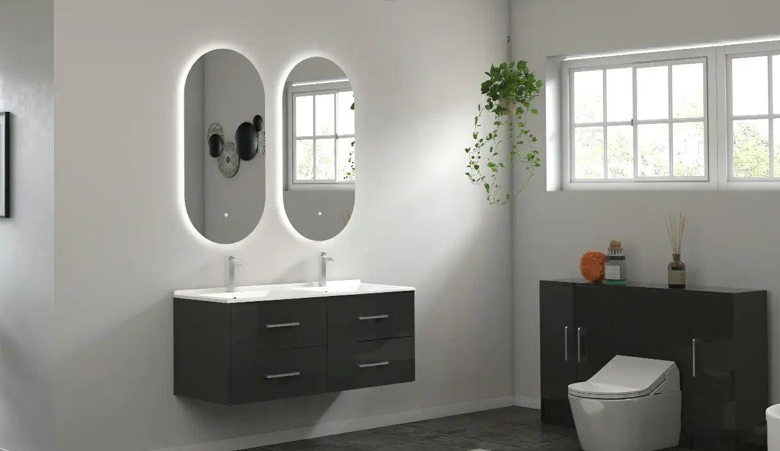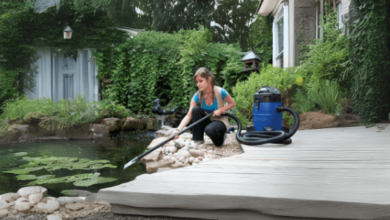Comparing Freestanding Vanity Materials: Pros, Cons, and Buying Tips

When it comes to bathroom design, the vanity often takes center stage—both in terms of function and style. And while size and layout matter, the material you choose is what truly determines how well your vanity performs over time. From durability and maintenance to everyday usability and overall look, the right material can make all the difference.
With so many options available, though, it’s easy to feel overwhelmed—or worse, to pick something that looks good at first but doesn’t hold up in real life.
In this guide, we’ll break down the most common vanity materials, highlighting the pros and cons of both countertops and cabinets. We’ll also share practical buying tips based on different bathroom scenarios, so you can avoid common mistakes and find the perfect match for your space.
1. Countertop Materials: Balancing Durability and Beauty
The countertop is the workhorse of any vanity. It’s where water splashes daily, where cosmetics and cleaning products land, and where your essentials rest. Because of this, it needs to be more than good-looking—it must also be waterproof, stain- and scratch-resistant, and tough enough for everyday life.
Below, we break down the five most common countertop materials—sintered stone, ceramic, solid wood, artificial stone, and quartz—along with their strengths, drawbacks, and best uses.
(1) Sintered Stone: The “Hardcore Durable” Modern Choice
Pros:
- Ultra-durable: Mohs hardness of 5–6 (just under diamond), resistant to scratches and high heat.
- Stain-proof: Dense, non-porous surface wipes clean easily.
- Stylish versatility: Available in a wide range of colors and marble-like patterns that complement modern, luxury, or industrial designs.
Cons:
- Heavy: Around 25–30 kg/m²; requires strong cabinetry or a load-bearing wall for floating vanities.
- Costly installation: Hard to cut and fabricate, which raises installation costs.
- Impact-sensitive: Can chip or crack if struck with something heavy.
Best for: Busy families with kids or pets who need long-lasting durability and a sleek, modern look. Opt for slabs at least 12mm thick and ask for stain-resistance certification.
(2) Ceramic: The “Classic & Easy-Clean” All-Rounder
Pros:
- Effortless cleaning: Smooth, glossy finish resists stains.
- Excellent waterproofing: Integrated ceramic basin and top prevent leaks.
- Budget-friendly: More affordable than stone, with timeless appeal.
Cons:
- Fragile: Mohs hardness of 3–4, meaning it can crack if hit hard.
- Limited designs: Shapes are fairly standard, with fewer customization options.
- Water spots: Needs regular wiping to stay spotless.
Best for: Budget-conscious households, rentals, or bathrooms designed for seniors. Look for high-quality glaze with a smooth, bubble-free finish.
(3) Solid Wood: The “Natural Elegance” Premium Pick
Pros:
- Unique beauty: Every piece has its own distinct grain pattern.
- Warm to the touch: Feels cozier than cold stone surfaces.
- Custom integration: Pairs beautifully with matching wood cabinetry.
Cons:
- Moisture-sensitive: Even sealed wood can warp in damp conditions.
- Maintenance required: Needs oiling or waxing every 3–6 months.
- Expensive: High-quality hardwoods and craftsmanship come at a premium.
Best for: Design enthusiasts who appreciate natural, artisanal finishes and don’t mind regular upkeep. For durability, ensure the wood has 8–12% moisture content and a waterproof finish.
(4) Artificial Stone: The “Flexible Custom” Option
Pros:
- Highly customizable: Can be molded into virtually any shape with seamless finishes.
- Endless colors: Thousands of shades and even creative inlays available.
- Easy repairs: Scratches and stains can often be sanded or polished out.
Cons:
- Low hardness: Mohs 2–3, making it easy to scratch.
- Poor heat resistance: Can warp or melt if exposed to hot objects.
- Environmental risks: Cheap versions may release harmful chemicals.
Best for: Younger homeowners or style-forward buyers who want trendy, colorful, or Instagram-worthy designs. Look for food-grade acrylic and E0 eco-certification.
(5) Quartz: The “Cost-Effective Durable” Favorite
Pros:
- Scratch- and stain-resistant: Mohs 4–5 with protective surface coating.
- Stable in humidity: Handles temperature changes well, ideal for bathrooms.
- Affordable durability: Less expensive than sintered stone but nearly as tough.
Cons:
- Limited design variety: Mostly neutral tones and marble-like veining.
- Visible seams: Requires sealant, which may discolor over time.
- Heavy: Around 20–25 kg/m², which may not suit lightweight cabinets.
Best for: Families looking for strong, reliable countertops without the luxury price tag. Choose quartz with at least 90% natural quartz content for maximum strength.

W2615GTS00123
2. Cabinet Materials: The Backbone of Waterproofing & Stability
A vanity’s cabinet isn’t just a storage unit—it’s the backbone that supports the countertop and withstands daily exposure to humidity. Choosing the right material ensures long-term stability, durability, and water resistance. Here’s a breakdown of the most common options:
(1) Solid Wood: The “Premium Quality” Classic
Pros:
- Luxurious natural grain and texture that adds warmth to any bathroom.
- Strong and long-lasting, often 10+ years with proper care.
- Eco-friendly with minimal formaldehyde emissions.
Cons:
- Higher price point compared to other materials.
- Requires regular maintenance; avoid prolonged water exposure.
- Heavy; installation must be secure.
Best for: High-end homes or bathrooms with traditional, rustic, or natural designs. Solid wood adds timeless elegance and tactile warmth.
(2) Plywood (Multi-Layer): The “Value & Stability” Choice
Pros:
- Highly stable and resistant to warping.
- More affordable than solid wood while supporting heavy countertops like stone.
- Versatile; can be finished with real wood veneers for a premium look.
Cons:
- Quality can vary—cheaper options may off-gas formaldehyde.
- Proper edge sealing is essential to prevent water damage.
Best for: Mid-budget homeowners seeking durability without breaking the bank. Look for E0-grade adhesives and high-quality veneers to ensure safety and longevity.
(3) PVC: The “Waterproof Economy” Option
Pros:
- Fully waterproof and corrosion-resistant.
- Lightweight and budget-friendly.
- Simple to install, making it ideal for small bathrooms.
Cons:
- Can feel cheap due to plastic-like appearance.
- Less stable in extreme temperatures.
- Lower eco-safety in inexpensive models.
Best for: Rentals, temporary setups, or tight budgets. PVC works well where durability is needed quickly, but it’s not ideal for long-term use in high-end bathrooms.
(4) Stainless Steel: The “Industrial & Durable” Statement
Pros:
- Rustproof, waterproof, and chemical-resistant.
- 100% free of formaldehyde, making it eco-friendly.
- Easy to clean with seamless welds possible for a sleek look.
Cons:
- Cold, hard aesthetic that fits minimal or industrial styles best.
- Shows fingerprints and water marks easily.
- Custom shapes or finishes can be costly.
Best for: Coastal homes, allergy-conscious households, or industrial-style bathrooms. Choose 304 stainless steel (non-magnetic or low-magnetic) for maximum durability and corrosion resistance.
See also: From Etsy to Empire: Packaging Lessons from Homegrown Creators
3. Buying Guide: Matching Needs, Style, and Budget
Finding the right freestanding vanity is all about balance. The countertop and cabinet materials should work together not only in durability and function but also in design and cost. A few simple rules can help you avoid regrets:
Match the function: Choose materials that can handle daily wear, water, and humidity.
Unify the style: Keep your vanity’s look consistent with the overall bathroom vibe—modern, rustic, or industrial.
Respect your budget: Don’t overspend, but don’t cut corners on key quality features either.
Quick Recommendations
| Scenario | Countertop Materials | Cabinet Materials | Key Considerations |
| Family with kids | Sintered stone, Quartz | Plywood, Stainless steel | Durable, safe, and easy to clean |
| Seniors’ bathroom | Ceramic, Quartz | Solid wood, Plywood | Stable, easy maintenance, rounded edges |
| Rental/temporary | Ceramic, Artificial stone | PVC, Plywood | Affordable, low-maintenance |
| High-end design | Sintered stone, Solid wood | Solid wood | Luxury feel, seamless design |
| Industrial/minimal | Sintered stone, Stainless steel | Stainless steel | Rugged, modern aesthetic, waterproof |
| Humid climate | Sintered stone, Ceramic | Stainless steel, Plywood | Mold-resistant, highly water-resistant |
By thinking through your household’s needs, your bathroom’s style, and your budget limits, you can zero in on the vanity materials that will give you both confidence and lasting value.
Final Thoughts
Never pick a vanity based purely on looks. A beautiful countertop or cabinet that warps, stains, or cracks within a year isn’t worth the investment. Prioritize function first—durability, waterproofing, and ease of maintenance—then consider style. Always ask for certifications on waterproofing, formaldehyde emissions, and material strength to ensure long-term quality.
For a reliable blend of style, craftsmanship, and practicality, Giving Tree Home’s freestanding vanities are an excellent choice. Their collections offer thoughtfully designed cabinets and countertops that stand up to daily use while elevating the look of your bathroom. Choosing one means you don’t have to compromise between beauty and performance.



